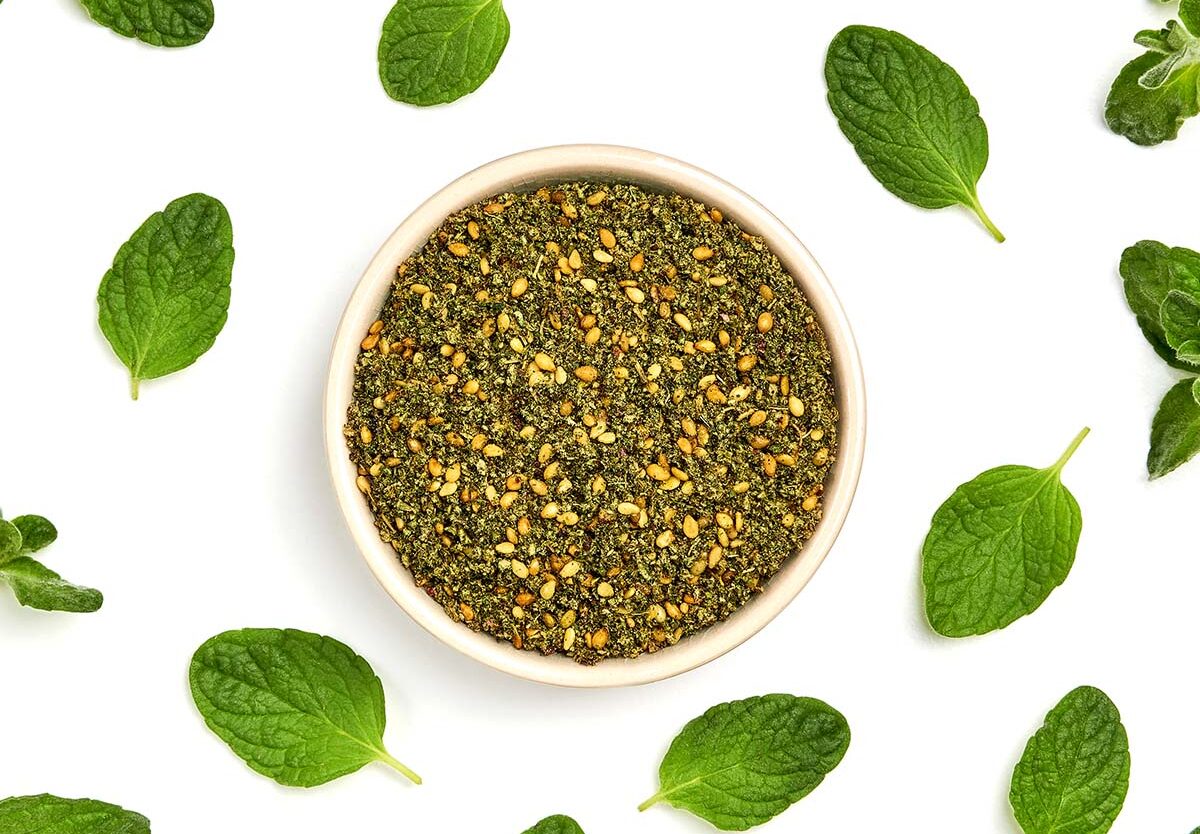Za’atar Day, on September 23, is observed as a cultural holiday that celebrates the Za’atar herb which is a staple in most traditional dishes in North Africa and the Middle East. Za’atar is used as a seasoning for meats and vegetables or it can be sprinkled as a seasoning on hummus. Za’atar is also eaten with labneh, a tangy, creamy cheese made out of yogurt, bread, and olive oil for breakfast. Za’atar features most commonly in Jordan, Palestine, Israel, Syria, and Lebanon, as well as other places in the Arab world. The Lebanese specialty “shanklish,” which is dry-cured balls of labneh, can be rolled in za’atar to form its outer coating.
History of Za’atar Day
In Jewish tradition, Saadiah, Ibn Ezra, Maimonides, and Obadiah ben Abraham all identified the “ezov” mentioned in the Hebrew Bible with the Arabic word ‘za’atar’ which is particularly associated with ritual purity ceremonies, like preparing the ashes of the red heifer. The Children of Israel are also said to have used some of ezov/za’atar stalks to smear the blood of the Paschal sacrifice on the doorposts of their houses right before leaving Egypt. Za’atar has been used as a staple in Arab cuisine since medieval times and up till the present day, along with other spiced salts. Za’atar has historical significance for Palestinians, some of whom see the presence of za’atar as the symbol of a Palestinian household. For Palestinian refugees, and other Palestinians in foreign lands, cultural plants and foods such as za’atar are a representation and reminder of the house, village, and region from which they hailed. There is archeological evidence that a za’atar plant was known and used in Ancient Egypt, though its ancient name has not been definitively determined. Remains of a species used in modern za’atar preparations, known as Thymbra spicata, were found in the tomb of Tutankhamun, and this particular species was known to the Ancient Egyptians as “saem” according to Dioscorides. Ecologists discovered that wild za’atar in Israel was on the verge of extinction due to over-harvesting and in 1977, a law was passed declaring it a protected species.
Za’atar Day timeline
It is said that the Israelites in Egyptian captivity use some shrubs of za’atar plants to daub blood on their doorposts during the Paschal sacrifice.
Palestinian and some other Arab cultures believe za’atar to be medicinal and use it to this effect.
Za’atar is declared a protected species in Israel and a fine is attached to the act of harvesting it.
Authorities at Israel Defense Forces (I.D.F.) checkpoints begin to confiscate za’atar plants.
Za’atar Day FAQs
What is the shelf life of Za’atar?
Za’atar can last up to two years from the date of its preparation, which is the time the ingredients are ground and mixed, if stored in an air-tight container and away from sunlight, heat, and moisture.
Is Za’atar proteinous?
The seeds are an excellent source of essential minerals including copper, magnesium, iron, calcium, and zinc. They are also rich in dietary fiber as well as high-quality protein.
How many calories are there in Za’atar?
There are 278 calories in a portion of za’atar.
Za’atar Day Activities
Add some za’atar to your meals
In the spirit of Za’atar Day, how about you add some spice to your meals by including za’atar in your dish? You should try it!
Prepare some musakhan
Za’atar is of historical and cultural value to Palestinians, and so is musakhan. It’s a good idea to prepare (and eat) some musakhan flavored with za’atar for Za’atar Day.
Share your best recipes online
Do you have any great ideas or recipes for Za’atar flavored meals? Yes? Then you should share these ideas online using the #Za’atarDay hashtag.
FAQs
It was once used in ancient mummification
In Ancient Egypt, some of the dead were mummified with za’atar.
Used as air fresheners in Greek temples
Za’atar is used as an air freshener in temples in Greece.
It is used to treat infections
It is used medically to treat bacterial and fungal infections.
It was famously featured in Shakespearean works
During Shakespearean times, thyme became more popular because Shakespeare used it in his literature.
It is a staple Arabic condiment
Za’atar is one of the most symbolic aspects of any Arabic kitchen.
Why We Love Za’atar Day
It adds flavor to meals
Za’atar spices up our meals and adds the much-needed flavor! Today’s the perfect opportunity to try it out in a new recipe.
It is of cultural value
Za’atar is of cultural and historical value to most Arabs. Learn more about it on this day.
Za’atar is medicinal
It can be used in the treatment of certain types of infections. Find out ways in which you can use za’atar in your daily life.
Za’atar Day dates
| Year | Date | Day |
|---|---|---|
| 2025 | September 23 | Tuesday |
| 2026 | September 23 | Wednesday |
| 2027 | September 23 | Thursday |
| 2028 | September 23 | Saturday |
| 2029 | September 23 | Sunday |





















